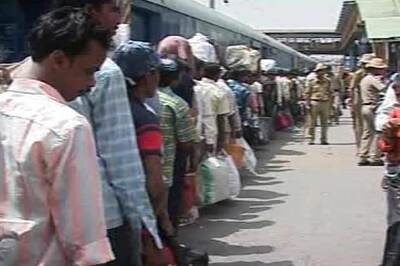
views
MYSORE: Bylukuppe, the largest Tibetan settlement outside Tibet, was a jungle in 1960s when the first batch of Tibetan refuges numbering around 500 came after travelling 2,000 kms from their home land. Today, it is a clean town and a major tourist centre with Golden temple and a lot of monasteries. The settlement also has the best education institutes and a Tibetan medical centre. It is now known for its best and modern agriculture practices as well.Five thousand acres of land given in two phases to 5,000 individuals of Lugsum Samdupling (Old settlement in 1961) and Dickgi Larsoe (New settlement in 1969), both adjacent Tibetan refugee settlements, over the years, has been made selfsufficient to feed a population of 50,000 people and lead their livelihood.The settlements also include more than 9,000 monks and nuns other than the families of the refugees.The refugee families, basically nomads, upon arrival here had to learn a lot apart from their knowledge of minority farming for their livelihood and survival.They survived on the food grains supplied by the government for a couple of years and tried to grow horse gram.These refugee Tibetan community which had no knowledge of Kannada or any other Indian languages struggled for years and managed to live on with nonverbal communication to communicate with the local population.In the beginning, the Tibetans also worked as labourers in the nearby towns for their survival. But today, the 5000 acres of jungle granted to them is the best fertile land which has recorded the highest yield of maize.Today, the Tibetan farming families have overtaken Kolar farmers in hard work and adopting modern methods of cultivation.They have switched over to multi-cropping pattern to make agriculture a lucrative practice and adopted pest management, organic farming and integrated farming methods.Blessed with land in assured rain fall area between Mysore and Kodagu districts, the Tibetan progressive farmers are growing ginger, watermelon, areca nut, betel leaf, palm, mulberry, paddy, ragi, maize, jowar, banana, potato, chilly, tomato, vegetables like ring beans , bitter guard and other crops keeping in mind the local market and also demand in open market in neighbouring Kodagu and Mysore markets. A few of them are successful in cultivating commercial crops like Tobacco, Cotton which have better market facilities in Periyapatna and H D Kote Taluks of Mysore district.The Tibetan refugees, though exiled and settled here away from their homeland, have maintained their culture intact. This settlement has now become a model settlement from which one can learn a few things.Both Indians and Tibetans are living here in harmony.They have extended facilities like Tibetan medical services to Indian community, other than taking part and exchanging wishes during the festival. They have depended on the local labourers during the sowing, harvest and also for cultivating the horticulture crops.As the population increased over the years with no scope for more land, the Tibetans extended their activities taking fellow Tibetans’ land and the land owned by local Indian families lease.Many of them had to move to metros, abroad for higher education depending on their financial conditions and assistance from their government in exile due to the shortage of land for lease and increasing land prices.Those who stayed here travel to Lhasa and Nepal border to purchase jackets, clothes, shoes and slippers to sell them in cities like Bangalore, Chennai, Madhurai, Mysore, and other cities across the country before monsoon sets in Cauvery catchment area.Residents speakDorjee Gonpo (70) of Pulang camp, opposite to Bylukuppe settlement, said that he was in his early 20s when he came here with his parents from Tibet. “I had managed to communicate and move with local population making signs for the first couple of years,” he said. Now, he knows three Indian languages, earns a minimum of `400 per day by selling ring beans.“Initially, it was difficult to grow jowar, ragi with horse gram. Slowly, I started growing ragi and maize other than horticulture crops,” he said.Gonpo and his wife have ensured that their four children are well educated. They serve in Bangalore, Dharmashala and Delhi. “Horticulture crops like banana have helped me a lot monetarily and I have been able to provide good education to all my children. I have also married them off,” he added.Namgyal, a progressive farmer, has managed to cultivate more than 25 acres of land with minimum consumption of power and labourers.A higher secondary dropout who is into business, Namgyal switched over to agriculture with five acres of land his family had.“I started my experiment with ginger and spent a couple of months in Kolar to learn about modern farming methods and growing horticulture crops. A bumper ginger crop boosted my morale and encouraged me to take land on lease and try banana and areca nut,” he said.He has grown mulberry in 4.5 acres along with palm and has set up sheds for sericulture.He has also have tried his luck with the cultivation of watermelon other than tomato for a couple of seasons.This Tibetan enterprising youth who felt the heat of short of labourers adopted drip irrigation installing sprinklers and took advantage of the government schemes and installed solar to operate 5 hp motor, sprinklers .“When India is importing 70 per cent of palm oil from Malaysia, why should we try and take advantage of the market?” he asked.The Tibetans settlements have managed to set up local wind mills to cut down high power bills and use them for pumping of water to overhead tanks of 10,000 to 20,000 litres capacity.‘We want to return good land’Secretary of Regional Tibetan Youth Congress Jimpa said that the Central Tibetan Advisory Committee, under their Government in Exile, has advised the farming community to switch over to organic farming. He said that 1/4th of the land in Pulang camp area is under organic farming. Though, the farmers fear that the production may come down diametrically, adopted organic farming methods, they are told to try in phases. “We are committed for encouraging organic farming. When we go back to Tibet, we want to give back good land free from chemicals,” he said.Society’s saga of successTibetan Dickey Larsoe Primary Agricultural Credit Cooperative Society Limited, Bylukuppe, Chief Executive Officer Chime Dorjee said that all farming Tibetan families are members of the society which has a turn over of `3 crore. He said that the society takes order and supplies seeds, fertilizers and purchases maize and other grains harvested from the farmers.He said that they have availed of benefits from Union and State governments and have covered all members under Yashasvini scheme. LOOKING BACKThe first batch of Tibetans which arrived to clear jungle and make way for those arriving in batches to Bylukuppe had vision of encouraging agriculture activities among the refugees for their livelihood and make them self-sufficient in every possible way. They started the Tibetan Primary Agricultural Credit Cooperative Society Limited in the two settlements of Bylukuppe. They extended loans and facilities through this society and expanded area of cultivation.Over the years, they also organised workshops and interactions with officials, other than organising field visits. In 1964, the society started a workshop and tractor division and purchased 14 tractors and tillers to facilitate its members to carryout farming activities in a full swing. Thumpen, manager, tractor division, said that the society charges `336 for ploughing for one hour and `360 to nonmembers.The price is considerably less than to open market. But, the demand for tractors has come down as 25 tractors are purchased individually by the families there. He said that as families have grown and population shot up over the years, many of them are into paddy and clothes business in the settlements.EDUCATION AND RESEARCHThe Tibetan Medical and Astrological College is one of the most important educational institutes which trains students in traditional Tibetan system of learning. The educational courses are provided in Traditional Tibetan Medicine and Astrology. The graduation courses include medicine, astrology, philosophy, practical applications and science.The courses provided are a five-year Kachupa Degree or Bachelor of Tibetan Medicine for the medical students and a five-year Tsipa Kachupa Degree or Bachelor of Tibetan Astronomy and Astrology for students of astrological sciences.Besides, there is also a one-year internship for medicine and astrology courses. In addition, a provision for enhancement of medicine and astrology courses from six to seven years is being looked into.Admissions are on merit basis and the minimum education qualification needed is a pass senior secondary school level.Training and teaching of the two sciences are in Tibetan and fluency in the language is a prerequisite. Seats are allotted to Himalayan region and foreign students who are well versed in Tibetan. This institution of learning has already trained fourteen batches of doctors and seven batches of astrologers.Courses are offered to foreigners on Tibetan medicine and astrology every year. The course includes a five-day basic course and a ten-day advance course in English. This is organised by Tibetan Medical and Astrological College.Seminars and workshops are organised by Men-Tsee-Khang regularly inviting scholars of medicine, astrology and science to enrich the knowledge and experience on different systems of healing to the doctors, astrologers and students. T Clinical Research Department is an important unit for research analysis and documentation. The department conducts research on disorders like diabetes, cancer, hepatitis and hypertension (BP) in collaboration with western scientific system of analysis with All Indian Institute of Medical Sciences (AIIMS), New Delhi, Natural Medicine Research Centre, Hadassah, Israel and Department of Chemistry, University of Livepool, UK. Clinical research on the efficacy of Tibetan medicine with western lab test for research analysis according to scientific method has been initiated by this department. The college has many other departments too. TIBETAN MEDICINE SYSTEM■ The 2000-year-old Tibetan medicine system, being practiced at Bylukuppe and other 36 centres across the country, has been accepted by local people. The local community avails facilities at Bylukuppe and also a few more places like Hunsur, Bangalore, Mungod camp, Kollegal other than all metros in the country.■ Many foreign patients have tried Tibetan medicine as it is made out of herbs and shrubs prepared at Dhramashala.■ The Herbal Product Research Department of the Tibetan Medical and Astrological College manufactures herbal products for rejuvenating body and skin based on traditional Tibetan system of formulation in accordance with modern scientific methods. The herbal medicines are supplied from Dharmashala based the orders placed by all centres.■ Chief of the Tibetan Medical Centre Dr Prasaang Dhondup said that Tibetan medicines have proved best for blood pressure, diabetics, anxiety, fear and restlessness. He said that the cases of diabetics and gastro problems have increased due to change in lifestyles and food habits.The Tibetans have also held free camps to popularise medicine among the public and also help other to utilise their services.■ The Tibetan medicine system, more popularly known as Bodkyi Sowa Rigpa (The Knowledge of Healing of Tibet), is as old as Tibetan civilization itself. The system was developed by the earliest inhabitants of Tibet who were confronted with a host of complications due to the way of their living. They prepared some effective natural remedies for many common illnesses using natural things. Later, cultural exchanges with neighbouring countries brought new medical knowledge that influenced the Tibetan medicine.



















Comments
0 comment